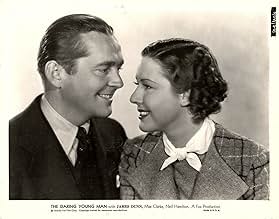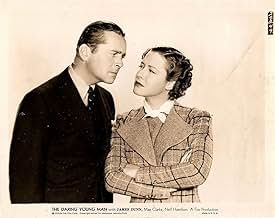Füge eine Handlung in deiner Sprache hinzuTwo reporters plan to marry but the bride is left waiting at the altar because her groom has gone undercover to expose gang activity.Two reporters plan to marry but the bride is left waiting at the altar because her groom has gone undercover to expose gang activity.Two reporters plan to marry but the bride is left waiting at the altar because her groom has gone undercover to expose gang activity.
- Auszeichnungen
- 2 wins total
Lynn Bari
- Bridesmaid
- (Nicht genannt)
Maurice Black
- Florist
- (Nicht genannt)
Empfohlene Bewertungen
What starts off as an amusing little romantic comedy (a lovely music score adding to its charm) develops quite startlingly into something else, namely a sort of precursor to the 1960 Peter Sellers comedy, Two-Way Stretch. In the first half of the movie we are treated to a delicious portrayal by Arthur Treacher, enacting a bore of uncommon magnitude. But the real joys of cameo portrayal occur in the latter half of the film where the screenwriters excel themselves in delightful raillery: "I didn't know he was a reporter. I thought he was all right. I thought he was just a criminal." We also meet such unforgettable characters as Stanley Fields with his "little paroles", and Paul Hurst delivering his lines in a wondrous imitation of W.C. Fields: "Get back in that cell there!" and "I wonder if we could be arrested?"
We also thoroughly enjoyed slow-thinking Sidney Toler as a greedy prison warden and his tongue-twisting assistant, immaculate Jack LaRue as the king of the prison underworld. And not to forget Warren Hymer as a seeker for the perfect hiding place (a device re-used in Two-Way Stretch).
William A. Seiter was always a capable director, but Daring Young Man represents a considerable cut above his customary average. Take the remarkable sequence in which Dunn obtains a little parole. His streetcar is tailed by Hymer and Pawley who cut him down just as he reaches his girlfriend's apartment, the camera tracking away from his viewpoint just as she comes through the entrance.
Seiter's fast and snappy direction is lifted not only by fluid camera movement but by rapid dialogue delivery, an expert control of crowd scenes and quicksilver film editing.
All the players excel, with the possible exception of former silent star, Neil Hamilton, as the heroine's former suitor. Fortunately. he has only three or four scenes.
Production values are first-class and behind-the-camera credits likewise, although Mae Clarke is not always photographed to advantage. And it's a pity we don't see more of Dorothy Christy!
We also thoroughly enjoyed slow-thinking Sidney Toler as a greedy prison warden and his tongue-twisting assistant, immaculate Jack LaRue as the king of the prison underworld. And not to forget Warren Hymer as a seeker for the perfect hiding place (a device re-used in Two-Way Stretch).
William A. Seiter was always a capable director, but Daring Young Man represents a considerable cut above his customary average. Take the remarkable sequence in which Dunn obtains a little parole. His streetcar is tailed by Hymer and Pawley who cut him down just as he reaches his girlfriend's apartment, the camera tracking away from his viewpoint just as she comes through the entrance.
Seiter's fast and snappy direction is lifted not only by fluid camera movement but by rapid dialogue delivery, an expert control of crowd scenes and quicksilver film editing.
All the players excel, with the possible exception of former silent star, Neil Hamilton, as the heroine's former suitor. Fortunately. he has only three or four scenes.
Production values are first-class and behind-the-camera credits likewise, although Mae Clarke is not always photographed to advantage. And it's a pity we don't see more of Dorothy Christy!
Reporter James Dunn is at a wedding, explaining how all women are alike, looking for a man to take care of them, when he spots Mae Clarke. Twenty minutes later, they're about to get married, when his editor tells him he's going undercover to investigate a corrupt prison. Dunn writes a note to Miss Clarke, explaining how it's for both of them, and goes off, while his editor rips up the letter.
There are lots of fine comedy bits in this farce directed by William Seiter, including the open prison where Warren Hymer strolls in with two satchels of cash, giving one to warden Sidney Toler for a place to hide out for a few months, and Skippy as Miss Clarke's dog. However, the movie rushes along in its plot in such a clockwork fashion that it seems arch and heartless rather than funny and telling. It's a problem that Fox Films had in this era, before its merger with Zanuck's 20th Century: five credited writers making sure the individual bits worked, without making sure they hung together well. Despite a startlingly original comic thesis that was later used in TWO-WAY STRETCH, it's nothing more than a programmer.
Bob
There are lots of fine comedy bits in this farce directed by William Seiter, including the open prison where Warren Hymer strolls in with two satchels of cash, giving one to warden Sidney Toler for a place to hide out for a few months, and Skippy as Miss Clarke's dog. However, the movie rushes along in its plot in such a clockwork fashion that it seems arch and heartless rather than funny and telling. It's a problem that Fox Films had in this era, before its merger with Zanuck's 20th Century: five credited writers making sure the individual bits worked, without making sure they hung together well. Despite a startlingly original comic thesis that was later used in TWO-WAY STRETCH, it's nothing more than a programmer.
Bob
Top-Auswahl
Melde dich zum Bewerten an und greife auf die Watchlist für personalisierte Empfehlungen zu.
Details
- Laufzeit1 Stunde 13 Minuten
- Farbe
- Seitenverhältnis
- 1.37 : 1
Zu dieser Seite beitragen
Bearbeitung vorschlagen oder fehlenden Inhalt hinzufügen

Oberste Lücke
By what name was The Daring Young Man (1935) officially released in Canada in English?
Antwort























